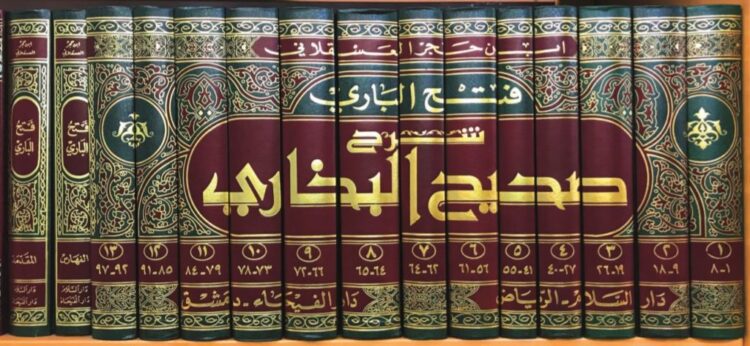Al-Khatib al-Baghdadi in Jami’ li Akhlaq al-Rawi and Ibn al-Salah, in his Muqaddimah, recommend the following curriculum which has been approved, expanded, and commented upon by al-Nawawi in al-Taqrib, al-Suyuti in Tadrib al-Rawi, al-Iraqi in his Alfiyyah, al-Sakhawi in Fath al-Mughith, and Zakariyah al-Ansari in Fath al-Baqi:
Commence by studying the sahih works of al-Bukhari and Muslim with care and attention. Al-Ansari and al-Sakhawi both state (perhaps from their teacher Ibn Hajar al-Asqalani) that al-Bukhari takes precedence due to the extreme care he took in extrapolating rulings, which is the greatest objective in studying hadiths, and its superiority over other collections in soundness. Al-Sakhawi added that al-Bukhari should be studied first unless called to Sahih Muslim by necessity, such as its narrator being the only one who has it and one fears his dying, as the narrators of Sahih al-Bukhari are many.
Thereafter, one should study the sunan works of Abu Dawud, al-Nasa’i, and al-Tirmidhi. Al-Ansari and al-Sakhawi state the same justifications here, either from each other or taken from their teacher Ibn Hajar al-Asqalani, namely that Abu Dawud takes precedence because of the great number of ahadith al-ahkam that it includes; thereafter al-Nasa’i as it trains one in hidden defects (‘ilal); then al-Tirmidhi due to the care he gives in indicating the hadiths in each chapter and section as well as indicating the gradings of each hadith. All this should be done by mastering precision and understanding their meanings.
Within this group, one must not neglect al-Bayhaqi’s Sunan al-Kubra, completed in 432 when the author was 48, ‘for we know not its like in its field’ as Ibn al-Salah said, who adds a caution not to be decieved by naysayers. Al-Nawawi said one should be devoted to it, as nothing has been written like it, and al-Suyuti agreed. Al-Sakhawi said that one must not limit oneself from it (by sufficing with the aforementioned sunan works) due to its comprehensiveness in most of the ahadith al-ahkam. Ahmad Shakir said in al-Ba’ith al-Hathith that it is the biggest book in legal hadiths (it has almost 22,000 narrations). Al-Sakhawi added that its true place should precede all of the other sunan works (i.e. Abu Dawud, al-Nasa’i, al-Tirmidhi, etc.), coming in rank only after al-Sahihayn, but they take precedence only due to being earlier. I might add that al-Dhahabi considered it to be one of the four masterpieces a scholar cannot do without, alongside al-Muhalla by Ibn Hazm, al-Mughni by Ibn Qudamah, and al-Tamhid by Ibn Abd al-Barr. Taj al-Din al-Subki said no other book had been written with such classification, arrangement, and quality. It includes most (if not all) of the hadiths found in al-Bukhari and Muslim, as well as many of those in Abu Dawud, al-Nasa’i, and al-Tirmidhi. The claim that al-Bayhaqi was unaware of al-Nasa’i and al-Tirmidhi is unfounded, because al-Bayhaqi refers to their narrations within his book, as Najm Abd al-Rahman Khalaf mentions in his book ‘al-Mawarid’ on al-Bayhaqi’s sources. Khalaf also includes, among hundreds of al-Bayhaqi’s sources: al-Bazzar, Ibn Khuzaymah, Abu ‘Awanah, al-Tahawi’s Sharh Ma’ani al-Athar, al-Daraqutni, Musnad Abu Hanifah, Musnad al-Shafi’i, Musnad Abu Dawud al-Tayalisi, Musnad al-Humaydi, Ibn Abi Shaybah, Ishaq b. Rahuwayh, Musnad Ahmad, Musnad al-‘Adani, Musnad al-Darimi, al-Musaddad, Musnad Abu Ya’la al-Mawsili, and many more. Scott Lucas argues that al-Bayhaqi cemented and sealed the hadith canon, and his choices were honoured by succeeding scholars.
Al-Khatib added Sahih Ibn Khuzaymah and al-Suyuti further added Ibn Hibban to this group, as did al-Sakhawi who also included Abu ‘Awwanah, Musnad al-Darimi, Musnad/Sunan al-Shafi’i, Sunan al-Kubra by al-Nasa’i because of the additions that it includes, Sunan Ibn Majah, Sunan al-Daraqutni, and Sharh Ma’ani al-Athar by al-Tahawi.
Then one should move on to the remaining musnad works that a scholar of hadith needs, such as Musnad Ahmad. Al-Sakhawi also added Abu Dawud al-Tayalisi, Ibn Humayd, al-Humaydi, al-‘Adani, al-Musaddad, Abu Ya’la, and al-Harith b. Abi Usamah, whose hadiths are higher than the aforementioned musnad works due to his living earlier.
Thereafter, move on to the musannaf works, beginning with Malik’s Muwatta. Al-Khatib al-Baghdadi said that al-Muwatta is the predecessor for this type (i.e. musannaf works) and thus it is necessary to start with it. Al-Suyuti adds Abd al-Razzaq and Ibn Abi Shaybah to this group, as does al-Sakhawi. Al-Sakhawi mentioned that musannaf works are of a lower ranking due to the majority of their contents being non-connected hadiths such as murasil.
One should then study ‘ilal al-hadith, headed by the works of Ahmad and al-Daraqutni. Al-Sakhawi added Ibn ‘Uyaynah, Ibn al-Madini, Muslim’s al-Tamyiz, Ibn Abi Hatim (whom he ranks with Ahmad and al-Daraqutni) with its commentary by Ibn Abd al-Hadi, al-Tirmidhi with Ibn Rajab’s commentary, and other works.
Alongside this one should study the ‘ilm al-rijal works, the best of which are al-Bukhari’s Tarikhal-Kabir and Ibn Abi Hatim’s al-Jarh wa al-Ta’dil. Al-Khatib ranks alongside these the views of Yahya b. Ma’in.
Finally, do not forget to study works on the precise spelling of names, the most complete of which is al-Ikmal by Ibn Makula.
Al-Nawawi added that Ibn al-Athir’s Nihayah fi Gharib al-Hadith as well as hadith commentaries should be relied upon throughout studying all of the above.
Ibn al-Salah concludes that every time one passes a problematic name or difficult word, one must research it and study it. One should follow the path of the early masters, who would memorise hadith with chains little by little, as few as two a day, reviewed day and night, in order to have complete mastery in the end.
